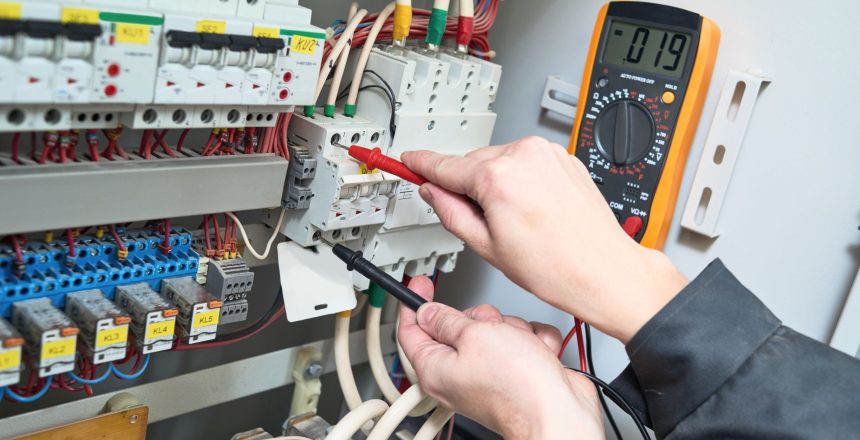Compliance Director, Andy Linley, discusses Arc Flash Boundary distances, what they are and factors affecting them.
Arc Flash Boundary Distances
According to NFPA 70E, three boundaries exist, these are Limited Approach Boundary, Restricted Approach Boundary and Arc Flash Boundary. Dependant on the remit of any arc flash study carried out, labels fitted to switchgear may make reference to one, or all of the above boundaries.
This article looks at the arc flash boundary, however, before moving on it is work discussing the limited and restricted approach boundaries that in fact relate to electric shock protection, rather than arc flash control.
Limited Approach Boundary- approach by Unqualified Persons. In Europe we would know this as an ordinary person, that being a person who is neither electrically skilled nor instructed and is the minimum distance that a non-competent person can approach parts that are energized and dangerous. Typically, in the UK, switchpanels contain live parts within enclosure and it is only when such enclosures are open and live parts are accessible does an issue exist.
Restricted Approach Boundary- approach by a Qualified Person. In Europe we would know this person as an electrically skilled or instructed person, in other words a competent person, again stating the minimum distance that should be maintained from exposed live parts in order to prevent electric shock.
The table below has been adapted from NFPA 70E, Table 130.4(E)(a)
Shock Protection Approach Boundaries to Exposed Energised Electrical Conductors or Circuit Parts for Alternating Current Systems.
| Nominal System Voltage Range, Phase to Phase | Limited Approach Boundary | Restricted Approach Boundary Includes Inadvertent Movement Adder | |
| Exposed Moveable Conductor | Exposed Fixed Circuit Part | ||
| Volts (V) | Metres (m) | Metres (m) | Metres (m) |
| Less than 50 | Not specified | Not specified | Not specified |
| 50 – 150 | 3.0 | 1.0 | Avoid contact |
| 151 – 750 | 3.0 | 1.0 | 0.3 |
| 751 – 15,000 | 3.0 | 1.5 | 0.7 |
| 15,100 – 36,000 | 3.0 | 1.8 | 0.8 |
| Note: the above distances may be different to those stated in company operational safety rules, DNO standards or transmission standards. | |||
Consider the arc flash warning label above which contains important information. It details the incident energy at the panel and the working distance, the arc flash boundary and the nominal voltage of that equipment. It also contains details relating to protective equipment to be worn when working on or near that equipment whilst it is live.
Incident energy value, which could be stated in a number of units, is often quoted as Calories per centimetre squared. This is the calculated energy that would be released on that equipment should an arc fault occur. It is important in that any personal protective equipment worn by operators of the equipment should be able to protect against the incident energy level that is present. It is worth noting that equipment that is well maintained and in good condition should be capable of being operated in its normal way. It should also be noted that if the supply of electricity has been removed from that equipment, the arc flash risk is removed.
The working distance is the minimum distance that should be maintained between accessible live parts and persons, their tools and other materials.
The nominal voltage is the phase to phase (line to line) voltage that should be expected at that point of supply.
The arc flash boundary is the minimum distance between an energised part and persons, without further protection measures such as barriers and enclosures, to protect against the thermal effects should an arc flash occur. At this limit the incident energy reduces to, or below 1.2 Cal/cm2, the threshold of where survivable second-degree burns occurs. Many companies mandate that this is the closest that persons can get to switchgear without the need to wear arc rated specific personal protective gear, whilst others will mandate this is the minimum distance whilst operating that switchgear, or whilst approaching that switchgear with doors open, or covers removed.
The arc flash boundary can vary, based on several factors, and is not simply a product of the operating voltage and the type of equipment or switchgear. It is often the case that incident energy values are higher on Low Voltage systems when compared with their High Voltage counterparts, and in some instances, more modern equipment and switchgear can have larger arc flash boundaries than more aged, but well-maintained equivalents.
When determining the risks that are present it is important to undertake a switchgear arc flash risk assessment, considering the incident energy value present, the arc flash boundary, the work that will be undertake and who will complete such work. Your arc flash study should contain guidance on how to carry this out, and your study provider should be able to provide instruction and training on how to do this.
Just as a reminder, the arc flash boundary is the limit at which, if an arc flash was to occur, a person would most likely sustain second degree burns which are survivable, without the need for further protective measures. In many cases, switchgear will be enclosed and will incorporate other control and mitigation levels to protect those in normal proximity to switchgear and equipment that is in normal service. Personal Protective Equipment, including arc rated PPE should only be considered as the primary risk mitigation method when all other options have been eliminated.




